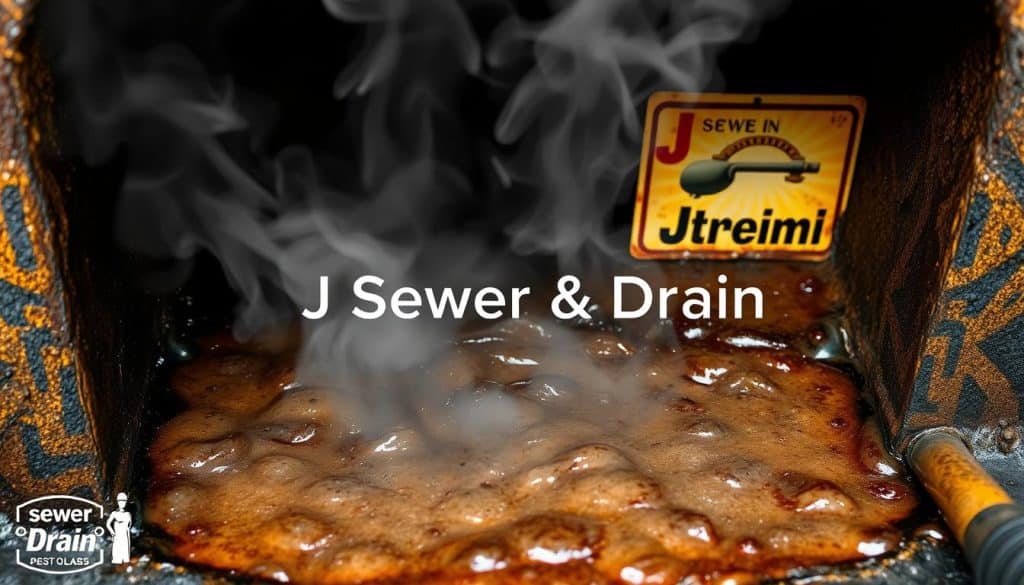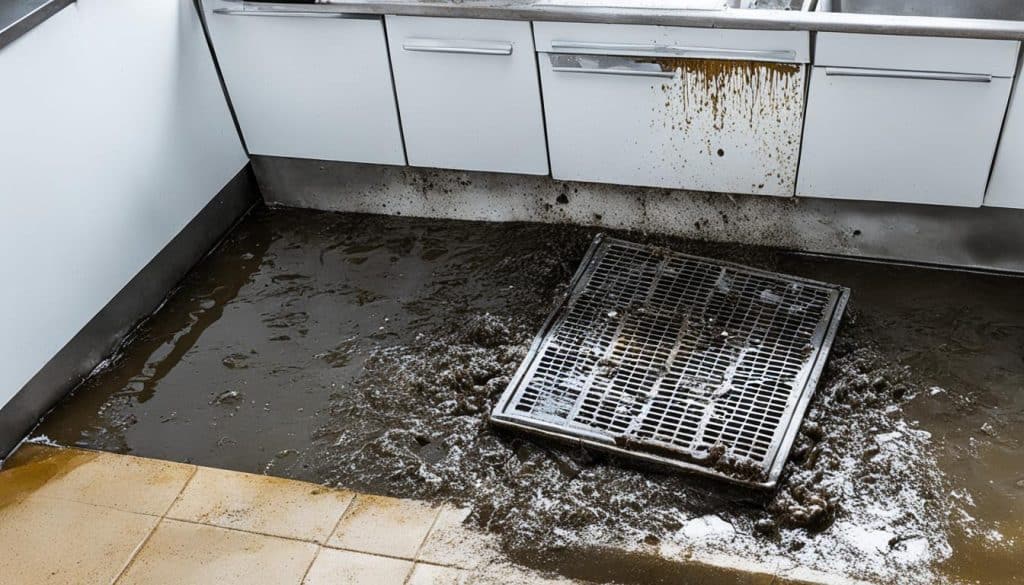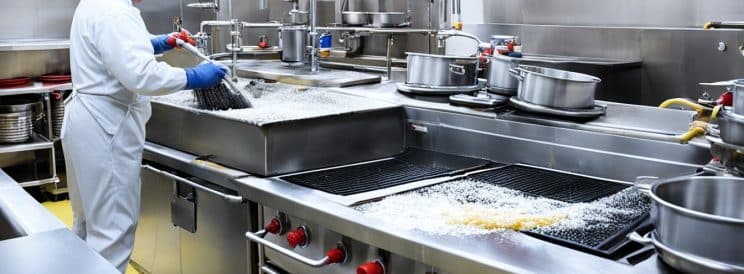Ever thought about How Often Should a Grease Trap Be Cleaned? Or if it’s causing hidden problems that could cost a lot to fix? Grease traps are needed to stop fats, oils, and greases (FOGS) from clogging sewers. But how often should they be cleaned depends on several things.
Key Takeaways
- Municipal regulations require regular grease trap cleaning to prevent sewer blockages.
- The average grease trap cleaning frequency for restaurants ranges from one to three months.
- Factors such as kitchen usage, size, and FOGS production influence cleaning schedules.
- Regular maintenance is essential to avoid inefficiencies and legal repercussions.
- Compliance with local regulations is crucial for smooth commercial kitchen operations.
Understanding the Role of a Grease Trap
Grease traps are key in managing fats, oils, and grease, or FOGS, in commercial kitchens. They separate FOGS from wastewater, making sure only clean water goes into the municipal system. This stops blockages and keeps businesses in line with rules, showing why cleaning and maintaining grease traps is crucial.
How Does a Grease Trap Work?
A grease trap catches wastewater and holds back FOGS before they hit the sewage system. Water with FOGS goes into the trap, where it slows down. Grease and oils float to the top, and solids settle at the bottom. Then, clean water exits through the bottom of the trap.
Why Are Grease Traps Mandated?
Local laws require grease traps to keep the environment safe and prevent sewer overflows. Keeping up with maintenance is key to avoid fines and legal trouble. Good FOGS management through well-maintained grease traps is vital for any food service to run smoothly.
The Importance of Regular Grease Trap Maintenance
Keeping up with a grease trap cleaning schedule is key for a commercial kitchen’s smooth running. Regular upkeep prevents many problems that come from ignoring this important part of the kitchen’s plumbing.

Preventing Blockages
A clogged grease trap can cause big problems in your kitchen’s drainage. Keeping up with a cleaning schedule stops fats, oils, and grease (FOGs) from building up. This way, you avoid clogs. Professional services can clean it well, keeping your kitchen running smoothly.
Avoiding Fines and Legal Issues
In many places, keeping your grease trap clean is the law. Not doing so can lead to big fines and legal trouble. By sticking to a cleaning schedule and using professional services, you avoid these problems.
Ensuring a Safe and Clean Environment
Regular grease trap maintenance is also about keeping your kitchen safe and clean. A well-kept grease trap cuts down on bad smells and health risks from bad waste disposal. Sticking to a cleaning schedule is vital for keeping everyone healthy.
Factors Influencing How Often a Grease Trap Should Be Cleaned
Keeping grease traps in good shape is key for any food service. The grease trap cleaning frequency depends on several important factors. These factors help decide how often these systems need to be cleaned to work well.
Kitchen Usage and Size
The size and how busy a kitchen is play a big role. Big kitchens, like those in steakhouses or diners, make more grease. So, they need to be cleaned more often than smaller kitchens in cafés or bistros. The food cooked affects how much grease the trap holds, so cleaning schedules need to be adjusted accordingly.
Volume of FOGS Produced
How much FOGS (fats, oils, grease, and solids) is made also matters a lot. Good FOGS management is key for the grease trap to work right. Places that fry or grill a lot need to clean their traps more often. But, using smart ways to reduce FOGS can help clean traps less often.
Local Regulations and Requirements
Following local regulations and requirements is also very important. Many places have strict rules about grease trap sizes and cleaning schedules. Following these rules is crucial to avoid fines and legal trouble. Regular upkeep helps food places meet these standards, protecting the environment and the business.
How Often Should a Grease Trap Be Cleaned?
Knowing when to clean a grease trap is key for any business that cares about kitchen upkeep. Grease traps need cleaning every 1-3 months. This follows both industry rules and the needs of each business. Cleaning regularly stops bad smells, prevents blockages, and keeps legal issues at bay.
The one-fourth rule is important for deciding when to clean a grease trap. It says to clean it when it’s one-fourth full. Following this rule helps manage fats, oils, and greases (FOGS) better. This keeps the kitchen running smoothly without interruptions.
Following the best cleaning practices for grease traps is vital. It keeps your kitchen in line with rules and running smoothly. A set cleaning schedule based on your kitchen’s use and FOGS volume is essential. Regular upkeep keeps the grease trap working well, making your kitchen clean and efficient.
Understanding the One-Fourth Cleaning Rule
To manage FOGS well, following the one-fourth cleaning rule is key. It says grease traps should be cleaned when they’re 25% full of fats, oils, grease, and solids. This rule helps keep grease traps clean and working right, avoiding blockages and keeping things running smoothly.
What is the One-Fourth Rule?
The one-fourth cleaning rule is a big part of keeping grease traps in good shape. It means cleaning the trap when it’s one-fourth full of FOGS. This keeps the trap working well and stops grease from leaking into sewers.
Why Adhering to This Rule is Crucial
Sticking to the one-fourth cleaning rule is important for many reasons. It stops FOGS from building up and causing sewer blockages, which can lead to big plumbing problems and expensive fixes. It also helps avoid fines for not following local health rules. By following this rule, businesses can keep things running smoothly and protect the environment.
Best Practices for Keeping a Grease Trap Clean
Keeping a grease trap clean is vital for any commercial kitchen. By following these best practices, you can keep your kitchen running smoothly and meet regulations. A solid maintenance plan is essential for avoiding problems and managing your kitchen well.

Regular Cleaning Schedule
Having a regular cleaning schedule is crucial. Clean your grease trap based on how much it’s used and local laws. Make sure to remove food waste, handle oil spills, and follow the one-fourth rule to prevent too much FOGS buildup.
Reducing FOGS at the Source
Reducing FOGS before it reaches the grease trap is smart. Teach your staff to scrape plates into bins before washing. Also, use strainers in sinks to stop big food pieces from getting into the grease trap. This helps keep FOGS levels down.
Recycling Waste Cooking Oil
Recycling waste cooking oil is good for the environment. Don’t throw used oil down the drain, as it can clog the grease trap. Instead, collect it for recycling. Many places can turn it into biofuel or other products, helping your kitchen be more sustainable.
Choosing Professional Grease Trap Services
Choosing the right grease trap services is key for your kitchen’s health and efficiency. J Sewer & Drain Plumbing Inc. is a top choice, offering solutions that meet both rules and needs.
The team at J Sewer & Drain Plumbing Inc. uses the latest methods to keep grease traps working well. Regular checks stop blockages and keep you in line with laws. This avoids fines and legal trouble.
Experts at J Sewer & Drain Plumbing Inc. provide detailed reports, crucial for meeting health and safety standards. In Chicago, IL, they also offer parts and labor guarantees. This includes emergency services and special deals.
Going for professional grease trap services means investing in your kitchen’s long-term success. With J Sewer & Drain Plumbing Inc., your kitchen stays up to code and runs smoothly. This cuts down on downtime and boosts productivity.
Conclusion
Keeping your grease trap clean is key for any food place. It helps you run your kitchen well, follow health rules, and keep things clean and safe. A regular cleaning schedule stops blockages that could cost a lot and get you fined.
Knowing the one-fourth rule is also important. It makes sure your grease trap works its best.
How often you clean your grease trap depends on your kitchen’s size, how much fat, oil, and grease you use, and local laws. Following best practices like regular cleanings, cutting down on FOGS, and recycling cooking oil keeps things running smoothly.
Choosing experts like J Sewer & Drain Plumbing Inc. for your grease trap needs is a smart move. They help you follow health rules and keep your kitchen clean and safe. Using these tips will make your kitchen more efficient and protect your business from problems.






